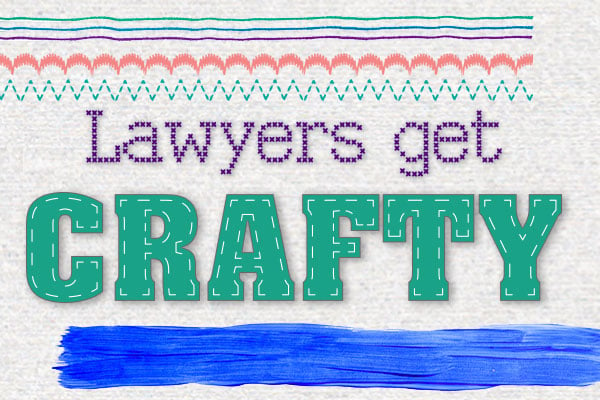Crafting helps high-achieving lawyers relax, recharge and have fun
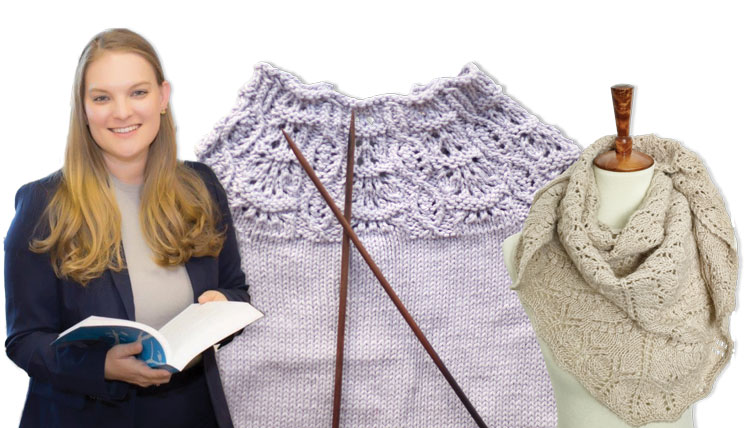
Lauren Clark Rad learned to knit to cope with finals at Harvard. Photos courtesy of Lauren Clark Rad.
KNITTING TO THINK—OR NOT
Crafting also provides a chance for busy brains to recharge in a way that seems to clear neural pathways for new ideas.
Russell says she’s definitely had ideas come to her while she’s creating. “Complex bankruptcies can be like three-dimensional chess, and you have to map out a strategy,” she says. “Sometimes when you step back from what you’re doing and let your mind relax and start wandering, you are able to see things that you couldn’t see before.”
Rad reports similar experiences. “Sometimes I’ll knit and ponder, and I’ll have to pause the knitting and shoot myself an email or jot down some notes,” she says.
Conversely, ERISA lawyer Beth Diamond believes she’s a better lawyer precisely because she never thinks about her job while she’s crafting. “I am just thinking about colors and shapes—it’s almost like a meditative experience,” she says. “Then when I go back to work, I have fresh eyes.”
Diamond is a multitasker by nature. “I am doing and thinking all the time—and not just about one thing, but three things. Even when I am relaxing, I am watching TV, making a list and thinking about what I am going to do the next day,” she says.
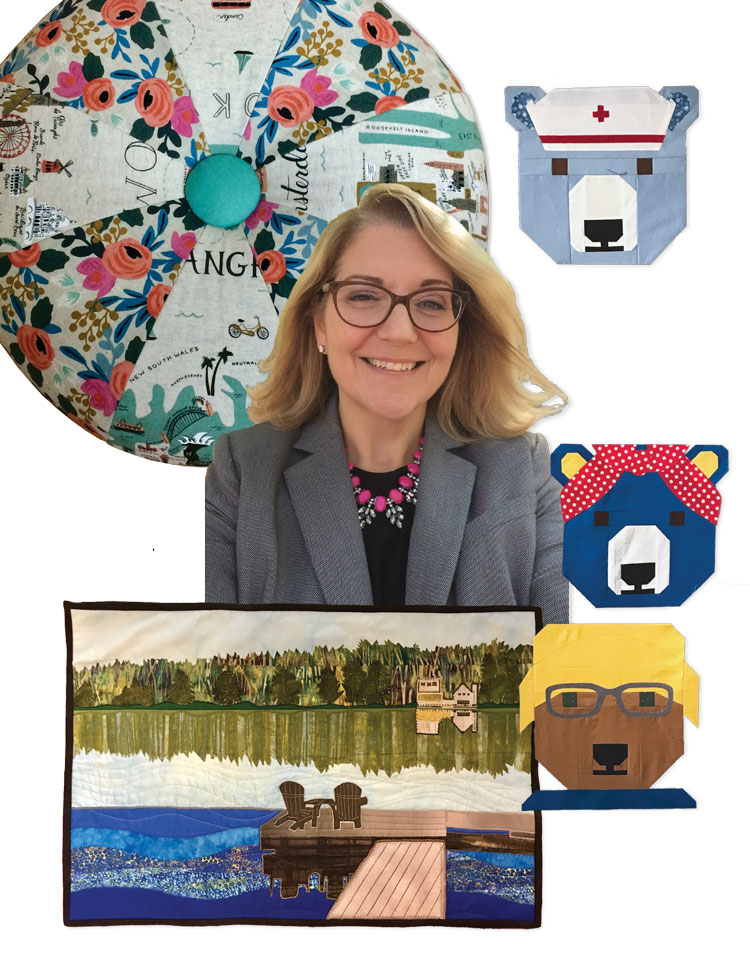
Beth Diamond makes personalized tuffets and quilts. Photographs courtesy of Beth Diamond.
It’s a perfect mindset for her work as an employee benefits investigator in the U.S. Department of Labor’s Boston office. Diamond spends her days studying large corporate health, welfare and retirement plans to ensure they comply with myriad federal laws so that plan participants can get the benefits they’re entitled to receive.
In all, she constantly juggles around 20 cases, each one extremely detail-oriented and each one with the potential to involve thousands of participants. “My cases are like kittens in a box—you have to attend to all of them,” she says. “There are some cases I want to work all the time, but I have to put them down and cleanse my brain.”
Doing that can be difficult, she admits. “I think it’s really hard to set down your work when you’re in the law—it’s hard to put it down and do something else and not have it in the back of your head.” That’s where crafting comes in. “I can get out of my head and do one thing for a little bit,” she says.

Photograph by Peych_P/Shutterstock.com.
Crafting also allows her to indulge her artistic side. At work, she says, “the most creative part of my job is coming up with spreadsheets and tables.” Once in a while, she admits that she’ll shift fonts from Times New Roman to Calibri just to mix things up.
At home, however, it’s a different story. There, creativity abounds. She’s quilted an elaborate scene depicting the view from her parents’ lake house, and she has made a baby blanket with quilted bear faces that she customized using fabric and colors that represent the hobbies and interests of each member of the baby’s family. Recently, Diamond learned how to make tuffets—little stools made of colorful cloth strips. She’s looking forward to making more tuffets and maybe even learning more new crafts. “I hope to someday be mellow enough to knit,” she says with a laugh.
Rebecca Berfanger also enjoys the ability to turn off her analytical mind and indulge her creative mind.
As half of Giles & Berfanger, a general practice firm in Indianapolis, she slants her practice toward serving the diverse legal needs of people in creative fields, such as arts, entertainment and journalism.
She and her law partner founded the firm in the fall of 2017, and getting it off the ground has been an undertaking, she says. In addition to investing in growing her practice, she juggles an entirely different set of deadlines stemming from her work as a freelance writer.
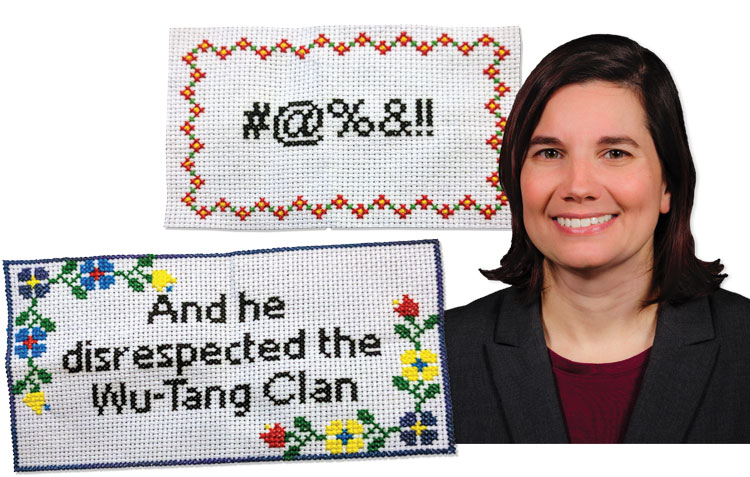
Rebecca Berfanger cross-stitches projects that combine pop culture and law. Photographs courtesy of Rebecca Barfanger.
Berfanger learned how to cross-stitch in middle school, but she renewed her interest when she discovered a book devoted to a new genre of the craft called subversive cross-stitch. These alternative designs draw on traditional patterns, including flowers and fuzzy animals, but instead of cloying phrases like “Home Sweet Home,” they feature rap lyrics, swear words and pop culture references. “It’s not how you’d normally think of cross-stitch,” Berfanger says. “It was inspiring and I thought, ‘This is something I want to do!’ ”
The designs Berfanger tackles aren’t technically complex, but they’re just hard enough to capture her attention—and sly enough to make her smile.
One recent project celebrated both pop culture and law, combining delicate flowers with the phrase “And he disrespected the Wu-Tang Clan.” The phrase, taken from the court transcripts of the jury selection process for the securities fraud case against Martin Shkreli, was a potential juror’s explanation of why he disliked the defendant. Wu-Tang Clan, a groundbreaking hip-hop group that originated in the 1990s, famously released an album with only one copy, which the recently convicted Shkreli owned.
Berfanger has also begun adapting patterns to incorporate her own slogans.
“It’s definitely a mental break where I can focus on one thing instead of 30 things,” she says. “I recently read that doing things with your hands is a good way to shut off your brain, and that makes sense. When I am doing cross-stitch, I can’t be at my computer.”
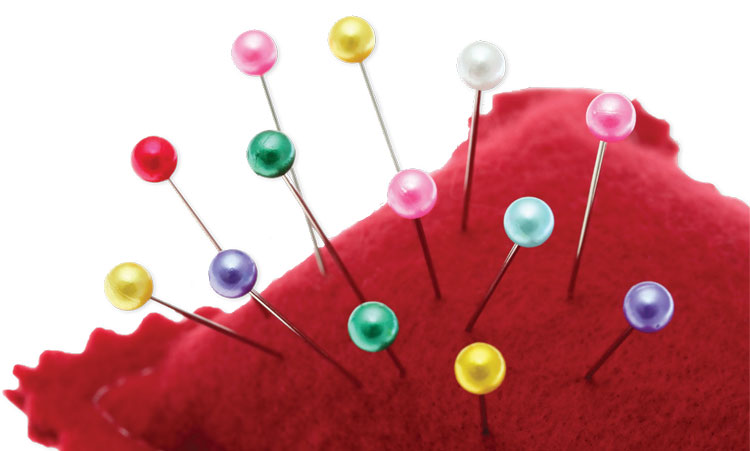
Photograph by Akiyoko/Shutterstock.com.

